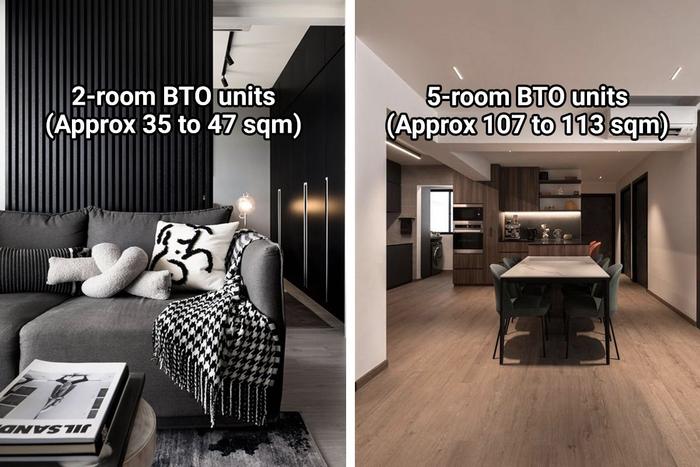From small to big.
Anyone who’s familiar with local housing (or is planning to propose to a significant other in a uniquely Singapore way) will surely know what a Built-To-Order (BTO) flat is. These high-rise homes have been built by HDB since 2001 – and just last year alone, there were 17,000 new units launched, with even more on the way in 2022 and 2023.

But to be even more specific, the BTO flat types that HDB currently offers are 2-room Flexi, 3-room, 4-room, 5-room, and 3-Gen units – all of which cater to different housing needs.
In this guide, we take a closer look at the most common layouts for each of these flat types, plus a couple of variants!
2-room Flexi BTO flats and their characteristics

View this project by Ataz Haus Interior Design
Designed with cosy living in mind, 2-room Flexi HDB units are perfect for any single person (aged 35 and above) who’s interested in having a home of their own in a non-mature estate.
Although there are two official types of 2-room Flexi BTO flats available (Type I and II), both are similar in room layout, comprising of a living area, bedroom, bathroom, kitchen, and a household shelter.

Example of a 2-room Flexi flat (Type I) floor plan at West Quarry @ Bukit Batok with a floor area of 38 sqm
The key difference between the two, then, lies in floor area. Type I units tend to range between 35 to 38 sqm, whereas Type II units tend to be 45 to 47 sqm large.
Looking at the floor plans of Type I and II 2-room BTO flats from the same HDB development (specifically, Punggol Northshore), this size difference can be mostly chalked up to the smaller living rooms and household shelters found in Type I homes.

Example of a 2-room Flexi flat (Type I) floor plan at Waterfront I & II @ Northshore with a floor area of 38 sqm.

Example of a 2-room Flexi flat (Type II) floor plan at Waterfront I & II @ Northshore with a floor area of 47 sqm.
In addition to Type I and II 2-room Flexi flats, there are also Community Care Apartments, which are catered exclusively to elderly residents above the age of 65.

View this project by Orange Interior
Other than having shorter lease periods (ranging between 15 to 35 years) and integrated care services, like 24-hour emergency monitoring and regular health checks, these Community Care Apartments are identical to other 2-room Flexi BTO flats for the most part.
3-room BTO flats and their features

Example of a 3-room flat floor plan at Pine Vista with an entryway household shelter and floor area of 69 sqm.

View this project by Posh Living Interior Design
3-room BTO units are larger than their 2-room Flexi counterparts with floor sizes ranging between 60 to 68 sqm, making them the ideal option for young couples who wish to settle down in a cosy home with the right amount of space for two.
Features-wise, all 3-room BTO flats possess two bedrooms, two bathrooms, a living area, kitchen, and storeroom/household shelter, but their internal layouts can vary slightly depending on which development they belong to and/or where they’re situated in an apartment block.

Example of a 3-room flat floor plan at Pine Vista with an internal walkway household shelter and floor area of 69 sqm.
For instance, the household shelters in 3-room flats at the Pine Vista development near Dakota can be found either beside the main door, or along the internal walkway – this detail is important as it can mean the difference between having the freedom to have an open-concept kitchen or not.
4-room BTO flats and their characteristics
4-room BTO units are perhaps the most popular HDB flat type among young families due to their ample space. Measuring roughly between 85 to 95 sqm, these homes are about twice as large as 2-room Flexi BTO flats (Type II).
But before balloting for one, it’s always worth checking beforehand the floor plan of any 4-room BTO flat that you’re interested in. And once again, this is due to differences in household shelter positions and kitchen layouts across HDB units/developments.

Example of a 4-room flat floor plan at Tampines GreenVerge with a floor area of 93 sqm.

View this project by ChengYi Interior Design
One of the most common 4-room BTO layouts (e.g. at Tampines GreenVerge) has the household shelter located outside of the kitchen/beside the main door, along with a kitchen that runs parallel to the central walkway.
But certain 4-room BTO flat layouts – like that of the soon-to-be-completed Woodleigh Hillside development – have a kitchen that runs perpendicular to the rest of the flat instead, making the entire cooking space longer than wide.

Example of a 4-room flat floor plan at Woodleigh Hillside with a floor area of 95 sqm.
Then there are more recent/future 4-room BTO units that have their household shelter located within their kitchen (e.g. 4-room homes at Tampines GreenVine), which makes them similar to their counterparts in past BTO developments such as Toa Payoh Crest.

Example of a 4-room flat floor plan at Tampines GreenVine with a floor area of 93 sqm.

View this project by Swiss Interior Design
And finally, there are 4-room BTO units with household shelters that are located between the kitchen and central walkway (e.g. at Yishun Glen), which are ideal for homeowners who prefer a closed-off galley kitchen bounded on both sides by structural walls.


View this project by ProjectGuru
5-room BTO flats and their features

Example of a 5-room flat floor plan at Melody Spring with a floor area of 113 sqm.

View this project by Ataz Haus Interior Design
Homeowners who are looking for a bigger BTO flat can opt for a 5-room unit. Although they have the same number of bedrooms and bathrooms as 4-room BTO flats, these units are more spacious with a floor size between 107 to 113 sqm – all thanks to a suggested study area located behind the living/dining area.

Example of a 5-room flat floor plan at Fernvale Dew with a floor area of 113 sqm and more room for an L-shaped kitchen counter.
Another characteristic that (most) 5-room BTO flats have in common with their smaller counterparts is room location, whereby every bedroom is situated along the same internal walkway.
But as always, there are exceptions to the rule. Like for example, 5-room BTO flats at Waterfront I & II @Northshore, which feature a more dispersed layout with a single bedroom located off to one side of the flat, and two in the other.

Example of a 5-room flat floor plan at Waterfront I & II @ Northshore with a floor area of 115 sqm.
Such a layout may be appealing to homeowners who would like a private area (e.g. a study or hobby room) that can be closed off from the rest of the house.

View this project by Urban Home Design 二本設計家
3Gen BTO flats and their characteristics

Example of a 3Gen flat floor plan at Woodleigh Hillside with a floor area of 120 sqm.

The defining feature of 3Gen BTO flats: a fourth bedroom located near the living area. (View this project by Met Interior)
Typically measuring between 115 to 118 sqm, 3Gen BTO flats are meant for families with multiple generations living under a single household – and to cater to everyone’s needs, these homes are extra-spacious and comprise of four bedrooms (two with en suites), a common bathroom, living/dining area, kitchen, and a household shelter.

Example of a 3Gen flat floor plan at Tampines GreenRidges with a floor area of 119 sqm.
Size aside, one common distinguishing factor between 3Gen flats and other BTO flat types is their layout, which too features a single bedroom located at one end of the house and three in the other, not unlike 5-room flats at Waterfront I & II @Northshore.
Finally, what’s also noteworthy about 3Gen BTO flats are the sizable communal areas located right in the centre, which are naturally the best spots for quality family time!
The article was adapted from MyNiceHome, HDB’s official website for all things related to home buying and renovation in Singapore. Check out the original article here.

 Get a budget estimate before meeting IDs
Get a budget estimate before meeting IDs